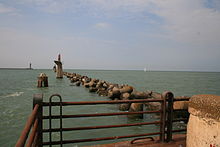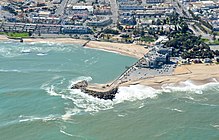
Alexandria is the second largest city in Egypt and the largest city on the Mediterranean coast. It lies at the western edge of the Nile River delta. Founded in c. 331 BC by Alexander the Great, Alexandria grew rapidly and became a major centre of Hellenic civilization, eventually replacing Memphis, in present-day Greater Cairo, as Egypt's capital. Called the "Bride of the Mediterranean" internationally, Alexandria is a popular tourist destination and an important industrial centre due to its natural gas and oil pipelines from Suez.
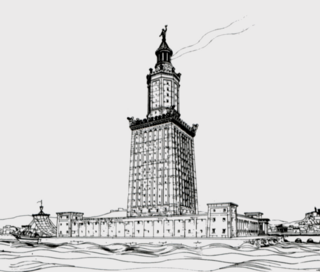
The Lighthouse of Alexandria, sometimes called the Pharos of Alexandria, was a lighthouse built by the Ptolemaic Kingdom of Ancient Egypt, during the reign of Ptolemy II Philadelphus. It has been estimated to have been at least 100 metres (330 ft) in overall height. One of the Seven Wonders of the Ancient World, for many centuries it was one of the tallest man-made structures in the world.

The Dunkirk evacuation, codenamed Operation Dynamo and also known as the Miracle of Dunkirk, or just Dunkirk, was the evacuation of more than 338,000 Allied soldiers during the Second World War from the beaches and harbour of Dunkirk, in the north of France, between 26 May and 4 June 1940. The operation commenced after large numbers of Belgian, British, and French troops were cut off and surrounded by German troops during the six-week Battle of France.

Tangier is a city in northwestern Morocco, on the coasts of the Mediterranean Sea and the Atlantic Ocean. The city is the capital of the Tanger-Tetouan-Al Hoceima region, as well as the Tangier-Assilah Prefecture of Morocco.

A groyne is a rigid hydraulic structure built perpendicularly from an ocean shore or a river bank, interrupting water flow and limiting the movement of sediment. It is usually made out of wood, concrete, or stone. In the ocean, groynes create beaches, prevent beach erosion caused by longshore drift where this is the dominant process and facilitate beach nourishment. There is also often cross-shore movement which if longer than the groyne will limit its effectiveness. In a river, groynes slow down the process of erosion and prevent ice-jamming, which in turn aids navigation.
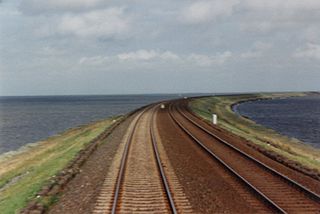
A causeway is a track, road or railway on the upper point of an embankment across "a low, or wet place, or piece of water". It can be constructed of earth, masonry, wood, or concrete. One of the earliest known wooden causeways is the Sweet Track in the Somerset Levels, England, which dates from the Neolithic age. Timber causeways may also be described as both boardwalks and bridges.

HMS Grenade (H86) was a G-class destroyer built for the Royal Navy during the 1930s. She was transferred from the Mediterranean Fleet shortly after the beginning of World War II for service in home waters. The ship participated in the early stages of the Norwegian Campaign in April 1940. German Junkers Ju 87 Stuka dive bombers sank Grenade as she evacuated Allied troops during Operation Dynamo on 29 May 1940.

Portland Harbour is located beside the Isle of Portland, Dorset, on the south coast of England. Construction of the harbour began in 1849; when completed in 1872, its 520-hectare (1,300-acre) surface area made it the largest human-made harbour in the world, and it remains one of the largest in the world today. It is naturally sheltered by Portland to the south, Chesil Beach to the west and mainland Dorset to the north. It consists of four breakwaters: two southern and two northern. These have a total length of 4.57 km (2.84 mi) and enclose approximately 1,000 ha of water.

English Tangier was the period in Moroccan history in which the city of Tangier was occupied by England as part of its colonial empire from 1661 to 1684. Tangier had been under Portuguese control before Charles II of England acquired the city as part of the dowry when he married the Portuguese infanta Catherine. The marriage treaty was an extensive renewal of the Anglo-Portuguese Alliance. It was opposed by Spain, then at war with Portugal, but clandestinely supported by France.

A breakwater is a permanent structure constructed at a coastal area to protect against tides, currents, waves, and storm surges. Breakwaters have been built since ancient times to protect anchorages, helping isolate vessels from marine hazards such as wind-driven waves. A breakwater, also known in some contexts as a jetty or a Mole, may be connected to land or freestanding, and may contain a walkway or road for vehicle access.

Saint Peter Port Harbour is located in Saint Peter Port, Guernsey. It was a natural anchorage used by the Romans which has been changed into an artificial harbour that is now the island's main port for passengers. Loose cargo, liquids and gas are shipped to and from St Sampson's harbour.
The Port of Alexandria is located on the northern coast of Egypt, to the West of the Nile Delta. In antiquity Alexandria was built between the Mediterranean Sea and Mariut Lake. The latter was connected to the River Nile via canals, allowing goods at the Port to travel to and from the country's interior.
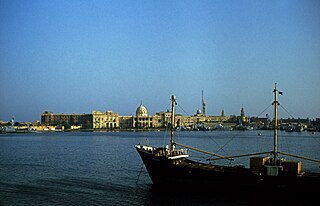
Ras El Tin Palace is a palace on the coast of the Mediterranean Sea in Alexandria, Egypt. It is one of the official residences for a serving President of Egypt. Under the Muhammad Ali Dynasty of Egypt and Sudan, it was a royal palace. Ras El Tin Palace is the oldest royal Egyptian palace still in use.

The Heptastadion was a giant causeway, often referred to as a mole or a dyke built by the people of Alexandria, Egypt in the 3rd century BC during the Ptolemaic period. The Heptastadion was created to link Pharos Island to the mainland coast and given a name based on its length. Overall it was more than three-quarters of a mile long.
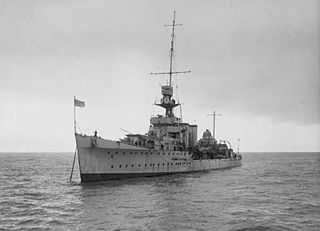
HMS Calcutta was a C-class light cruiser of the Royal Navy, named after the Indian city of Calcutta. She was part of the Carlisle group of the C class of cruisers. She was laid down by Vickers Limited at Barrow-in-Furness in 1917 and launched on 9 July 1918. Calcutta was commissioned too late to see action in the First World War and was converted to an anti-aircraft cruiser in 1939. Calcutta served during the Norwegian Campaign and the evacuation from Dunkirk in 1940. She was used to escort allied convoys across the Mediterranean and was sunk on 1 June 1941 by Luftwaffe aircraft off Alexandria, Egypt.

Captain Sir Edward Folmer Archdale, 3rd Baronet DSC was a British baronet, Royal Navy officer, submariner during the Second World War and local politician in Northern Ireland.

The Tangier Garrison was the land force which oversaw the defence of English Tangier between 1661 and 1684 when it was evacuated. It was part of the English Army, the de facto standing army that Charles II established following the Restoration. Charles II received Tangier as part of the Marriage Treaty with Portugal in 1661. He appointed Henry Mordaunt, 2nd Earl of Peterborough as governor and, on 30 January 1662, the new garrison took up its duties. Peterborough was not a successful appointment as governor, and Andrew, Lord Rutherford, was appointed in 1662/1663 to replace him.

HMS Sabre was an Admiralty S-class destroyer of the Royal Navy launched in September 1918 at the close of World War I. She was built in Scotland by Alex Stephens and completed by Fairfield Shipbuilding and Engineering Company in Govan. Commissioned for Fleet service in 1919, she was the first Royal Navy ship to carry this name.

D. Fernando de Meneses, 2nd Count of Ericeira was a Portuguese nobleman and military man. He was Governor of Tangier until 1661.

Portuguese Tangier covers the period of Portuguese rule over Tangier, today a city in Morocco. The territory was ruled by the Kingdom of Portugal from 1471 to 1661.


